The Cost of War We Don't See: Youth’s Humanitarian Crisis
- Young Diplomats Society

- Mar 20
- 3 min read
Natalie Yaacoub

War is often viewed through the lens of geopolitical interests, power struggles, territorial disputes, and the destruction of infrastructure. Human casualties capture global attention, while the visual devastation prompts an urgent response, and economic crises ignite political discussions. However, beneath these immediate effects of war lies what might be considered the greatest humanitarian crisis of all: the destruction of the present and future livelihoods of youth. The cost of war on young people surpasses all facets of human life, with both short-term and long-term consequences. Internal displacement, rampant poverty, and the collapse of essential services like healthcare and education erode the basic human rights that every child is entitled to. This crisis requires more fundamental policies and procedures to protect the human rights of youth from the ravages of war. The United Nations and world leaders must collaborate on creating a safer future for the younger generation.
War and Poverty
One of the most significant impacts of war on youth is the increase in poverty due to the destruction of infrastructure and economies. War magnifies the effects of poverty, stripping away opportunities for education, employment, and, most importantly, stability and security. Internal displacement caused by war leaves many young people without access to clean water, food, shelter, clothing, or schools. They also lack opportunities for vocational training. Article 24 of the Convention on the Rights of the Child asserts that “children have the right to the best health care possible, clean water to drink, healthy food, and a clean and safe environment to live in.” However, during war, this right is rarely upheld. The recent conflict between Lebanon and Israel exemplifies this, with over 300,000 children displaced in Lebanon. Nonprofit organisations such as UNICEF work to provide these children with essential services like clean water, food, psychological support, medical care, and temporary learning centres. While these efforts are critical, they do not change the grim reality that children affected by war are left with a diminished future. Proactive policies must be integrated into peace treaties to minimise the effects of war on youth.
The Short-term and Long-term Effects of War on Youth
War has devastating effects on youth, shaping both their present and future lives. In the short term, war strips children of shelter, safety, food, and clean water. Beyond these immediate impacts, war also erodes their future potential by obliterating opportunities for a better life. War forces young people to flee their homes, seek refuge in neighbouring countries and cope with the loss of family members. These traumatic experiences often result in anxiety, PTSD, and physical harm caused by malnutrition or injuries. In the long term, the consequences can be even more severe. Disrupted education systems leave children without the skills needed forfuture employment, placing them at a disadvantage compared to their global peers. In war-affected zones, over 7 million refugee children are out of school, and according to UNHCR, 14.8 million school-aged children are missing out on formal education. This deprives them of economic opportunities, leaving them vulnerable to exploitation and perpetuating cycles of poverty and instability. Furthermore, children raised in conflict zones often suffer from long-term mental health issues, experiencing severe psychological distress that hampers their ability to integrate into society. With only 1% of humanitarian funding allocated to mental health, governments and the international community must prioritise expanding mental health services for war-affected children and invest in training social workers and caregivers.
The Worldwide Humanitarian Crisis and International Response.
This crisis is not confined to third-world countries—it is a global humanitarian emergency. Countries like Lebanon, Israel, Palestine, Afghanistan, and Yemen have millions of displaced children in refugee camps. While political leaders may recognise the gravity of the situation, more decisive action is needed to protect the world’s youth from the effects of war. In response to this worldwide crisis, organisations like the United Nations, UNICEF, and UNHCR work to safeguard children’s rights during conflict. In 2022, UNICEF provided educational access to 37.9 million children through ad-hoc learning spaces and education supplies. Yet, 222 million children still need primary and secondary educational support. This highlights the challenge posed by political decisions, which often disrupt the efforts of international organisations. It underscores the need for a consensus among world leaders to enforce not only soft law but also international policies and treaties that will genuinely safeguard children’s rights during conflict. The youth are the architects of tomorrow’s world, and fostering peace is critical to ensuring a brighter future.
The future of our children, and indeed the future of the world, depends on the actions of today’s leaders and their collaboration with international efforts. War is a devastating force, and by prioritising the needs and interests of young people, we can protect the architects of tomorrow’s future.

















Comments